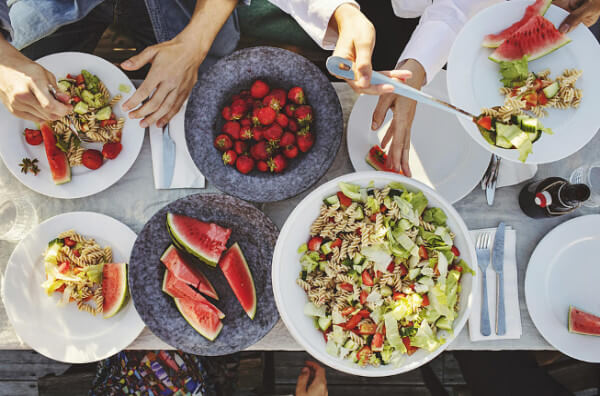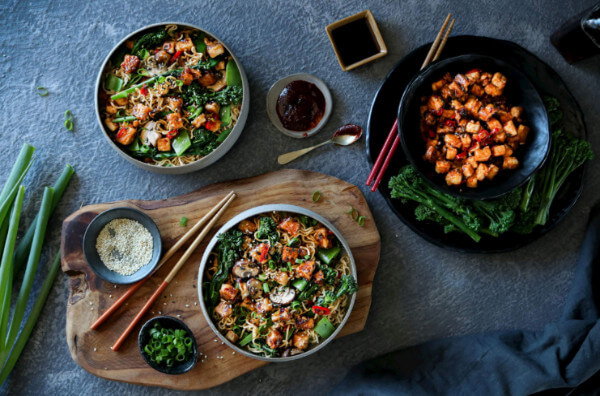Eat 5 servings of vegetables and fruits. A portion is one medium fruit or vegetable, about 80 g.
Use complex carbohydrates as the basis of meals: cereals, whole grain pasta and bread, etc.
Add plant-based dairy alternatives, such as soy milk or yogurt. It is advisable to choose low-fat products without sugar, enriched with calcium and vitamins.
Add vegetable sources of protein, such as legumes, and some unsaturated fats (nuts, seeds, vegetable oils).
Drink enough water without added sugar and fats.
A woman prepares a vegan dish

The most common mistakes vegan beginners make
People who rapidly switch to a plant-based diet put the body under considerable stress, which it begins to resist. Often the result is several basic mistakes made unconsciously, as a reaction of the body to sudden changes and a lack of understanding of the real nutritional value of plant products.
Excess calories
There is a very common misconception that vegan means healthy and less caloric. But often vegetable products have even more calories than ordinary ones. For example, you can order a seemingly perfect vegan brownie at a coffee shop, and then discover that one portion of the dessert contains 900 kcal. And this is about half of the daily norm of a healthy woman – after such a dessert you can stay full for almost the whole day.
In addition, the body, not receiving the usual amount of necessary nutrients, begins to send impulses to replenish, so a constant feeling of hunger may arise. At these moments, people often start abusing plant-based desserts and pastries, which are higher in carbohydrates and fats than traditional ones.
To avoid this, at the beginning of plant-based nutrition, you should read labels, inquire about the nutritional value of vegan products in stores, ask about calorie content in restaurants and cafes – usually, almost everywhere there is a technological map available with this information. This does not mean that you need to maniacally control the number of calories consumed to the hundredth and tenth, but it is important to learn to navigate in the world of new products and dishes.
Abuse of saturated fats
Modern nutritional recommendations – whether for vegans or not – say that it is necessary to add more unsaturated fats and less saturated fats to the diet. That is, saturated fats provoke an increase in bad cholesterol and, as a result, clogging of blood vessels (atherosclerosis) and increase the risk of developing cardiovascular diseases.
All animal fats are saturated, and therefore, at first glance, vegans have a more advantageous position, because they a priori refuse to consume most saturated fats. But in practice, among vegetable fats there are also saturated ones, mainly coconut oil. Most vegan desserts are made on its basis, it is often used for frying, especially in restaurants. Palm oil also belongs to saturated fats.
Here again, reading labels, understanding the composition of the dishes you see will help. Give preference to those products that contain unsaturated fats – for example, olive, sunflower, corn, hemp, sesame oil, grape seed oil, nuts and seeds.
Vegan curry
An excess of carbohydrates and a lack of proteins
The most obvious food group that a vegan can eat is carbohydrates. Vegan bars, whole grain waffles, cereals – these foods contain a lot of carbohydrates. If you give these products ¼ of a plate, then nothing terrible will happen. But if you make bread, cereal pasta, bread, vegan pastries and sweets the main part of the diet, forgetting about vegetables, fruits, seeds, nuts and protein products, the body will be overloaded with carbohydrates. Such an imbalance can provoke a constant feeling of hunger and, as a result, breakdowns, overeating and excess weight. In addition, fat, protein, vitamin and mineral deficiencies can occur, leading to muscle loss and other health problems.
The advice is unchanged: study the composition of products, use the plate method. Do not forget to look for new balanced recipes, and you can also try soy and other plant-based meat substitutes – these days they are becoming more and more accessible and diverse.

Vegan dish
A gradual path to veganism
There is no universal period of time required for the transition to a plant-based diet, because the start is different for everyone: someone eats red meat, sausage and eggs every day, and someone – mainly fish and chicken. For some reason, the path for everyone will be individual, but the main stages of abandoning animal products can be distinguished:
Exclusion of processed meat
Sausages, sausages, ham, pates, canned meat, etc. Meat, fish, seafood, dairy products, and eggs remain in the diet.
Rejection of red meat
Beef, pork, lamb, rabbit, duck, chicken and turkey thighs and drumsticks. White meat (turkey and chicken breast), fish, seafood, dairy products and eggs remain in the diet.
Gradual rejection of white meat and seafood
It has its own subcategories: first, the refusal of seafood
